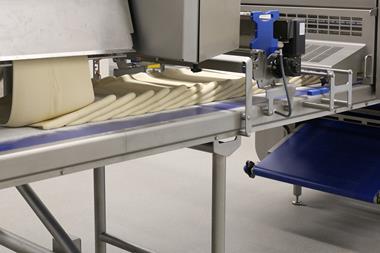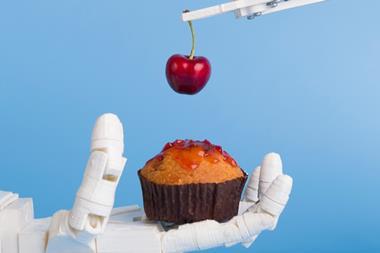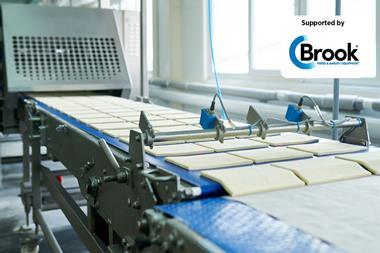Advanced systems and new materials are enabling businesses to track their bakeware and extend its usable life, bringing financial and efficiency benefits.
Spare a thought for your distant ancestors next time you pick up a baking tin. A rough bit of pottery – or even an upturned turtle shell – was the height of technology for stone-age cooks and the use of metal cookware wasn’t in widespread use until the early Middle Ages.
Now, ongoing technical developments mean bakers can grace their shelves with tins and trays that are evermore effective and efficient.
At the high-volume end of the business, leading-edge manufacturers are adopting tin recognition systems that would have been unthinkable just decades ago.
Kaak Group’s iBakeware is one such system. Each tin or group of tins (straps) has a 3D laser tag giving it a unique identity. The tin and its contents can then be tracked around the plant in real time. This data can be stored and linked to events in the plant, dough make-up, packaging and ingredient data from elsewhere.
iBakeware also provides historical data for tin coating life and other ‘events’ that relate to bakeware performance.
The latest bakeware designs use lighter, yet stronger materials that are more resistant to damage, and reduce energy requirements, says Bundy Baking Solutions vice-president of marketing Wendi Ebbing.
Changing industry demands and advancements in technology are driving continual development of new coating systems, according to Chris Higgins, sales executive and head of coatings at Invicta. Non-stick coatings are the surfaces of choice for the foreseeable future, he says, noting they have overtaken other coatings, such as silicon glaze and rubber, due to their financial benefits when used correctly.
New formulations are being developed, including reinforced coatings to help cope with wear and tear. And significant advancements have been made in technologies for ‘curing’ these coatings to help make them stronger and last longer.
Meanwhile, new bakery techniques, ingredients and products are also putting demand on coating and bakeware suppliers.
%%Quote_4%%
Gluten-free bread and products with a high sugar content are not always best suited to standard non-stick coating systems, for example, although Higgins says formulations have been developed to ensure these bread- and cake-makers can also benefit from cost-saving, non-stick coatings.
Just as important as what will go into a tin is how it will be handled during production.
For automated systems, the hardest thing on pans and tins is stacking and unstacking, which can scrape the inside of the pan and scratch its coating.
Pan stacks that are too high can damage the bakeware, although pan-strengthening features in the vessel can help prevent this, says Ebbing.
Other factors adding to the wear on tins include abrasions from cleaning with brushes or excessive air pressure, or accumulated ingredients.
Worn or damaged tins will not travel as easily on automated systems or fit so well or securely in ovens or storage racks. This can cause jams in the system and can also affect automated stacking and unstacking at the end of the line.
Moreover, badly worn tins can create an uneven product bake as the heat is not spread effectively. They can cause the product to misshape or create depanning issues, leading to high levels of wastage.
Higgins advises that a plant baker will usually invest in a new set of tins, knowing they will be able to re-coat them three times. After the third coat, they will replace them.
A long way from turtle shells and pottery, suppliers are working hard to ensure bakeware continues to move with the times.
CASE STUDY: London Bread & Cake
London Bread & Cake uses about 500 tins a day for bread, ranging from 200g, 400g, 500g, 800g to 1,200g or even 1,600g tins for special breads.
The business says it is unusual, as it has bespoke tins made for producing breakfast muffins and six-inch sub rolls to ensure products are baked to a precise size every time.
“Over recent years we have used larger tins so the resulting bread piece is larger and, more importantly, is softer to the feel as there is more air in it,” says MD David Hall (pictured below).
London Bread & Cake does not buy new tins, instead purchasing tins at auction.
“There are so many auctions at the moment, with bakeries closing down, that we buy second-hand at a good price or sometimes even get given them free,” adds Hall.
The business does not usually recoat its tins, but gives away ones it has finished with to new artisan bakery start-ups or good causes such as charities starting bakeries in Africa.
“In the past, when we had tins coated we would have a few coated and trial them first to ensure the supplier did a good job, then we would go in with a larger order,” says Hall.
With regards to trays, the business is changing from iron to aluminium or stainless steel as it finds these are easier to clean. It is also increasingly using stainless steel racks as it feels these are better in terms of food safety and hygiene, and more cost-effective in the long term.
“We use silicone paper, rather than mats as these are easier to clean, and better for food safety,” adds Hall. “We normally get three uses on a roll then, for the final use, bake Danish pastries or cakes where the paper gets fondant on and cannot be reused.”
Letting go
The use of release agents can help maintain the life of tins, and ensure consistency of products, say suppliers.
Bakels, for example, suggests its Tincol reduces problems caused to tins by carbonisation, rust and steam, giving protection and longer life to tins and trays. Most importantly, it provides a clean non-stick release of baked goods.
Lewis Davage, head of R&D and quality at Zeelandia, comments that it is not just the tins that are getting more advanced, grease and release agents are too.
Initially based on fats or oils such as lard, butter or oil, grease agents have evolved. More recently, driven by ‘cleaner’ food trends, allergen-free, more functional products have been developed.





























No comments yet